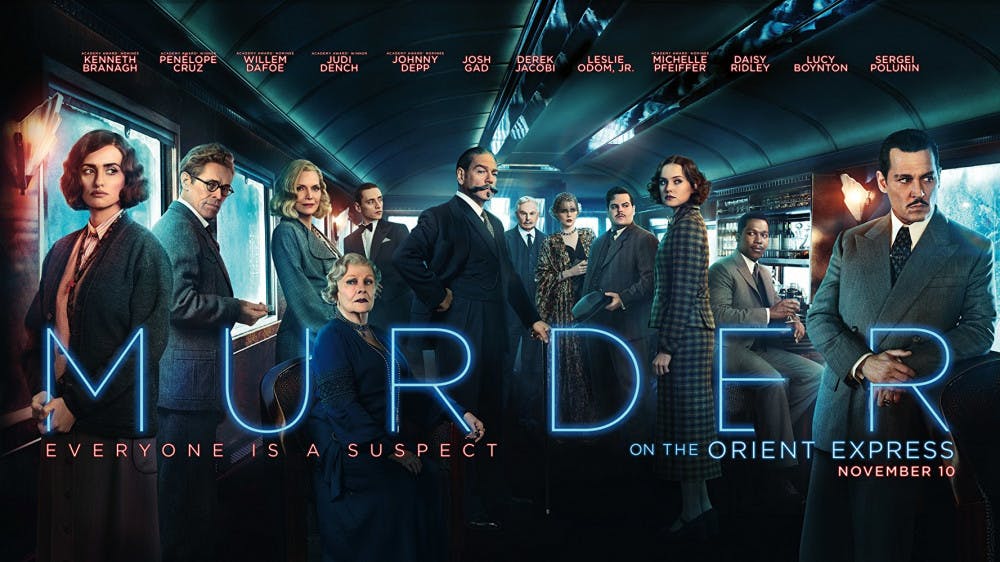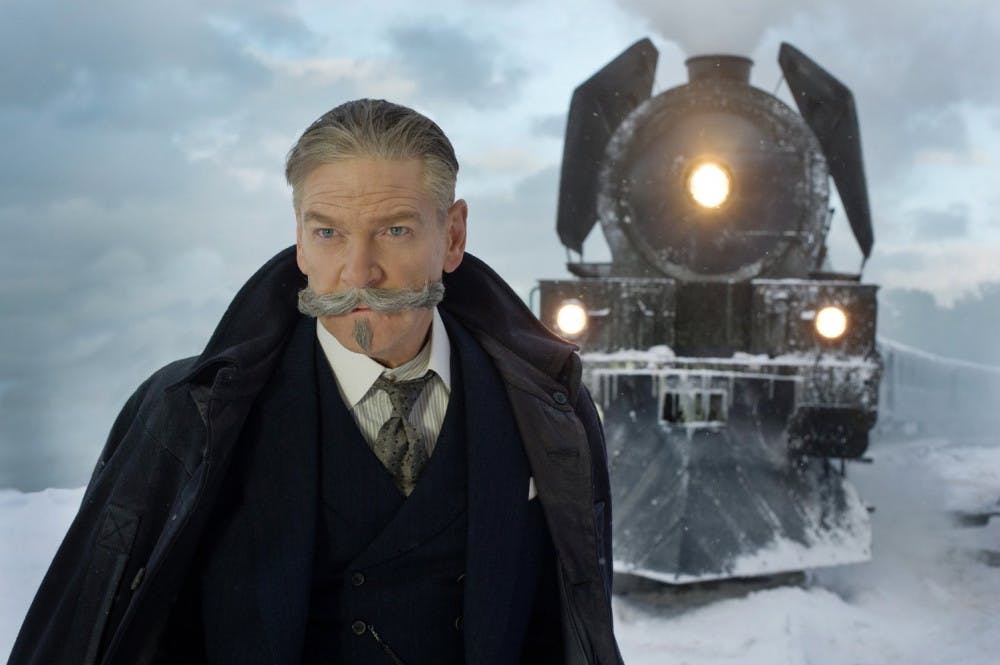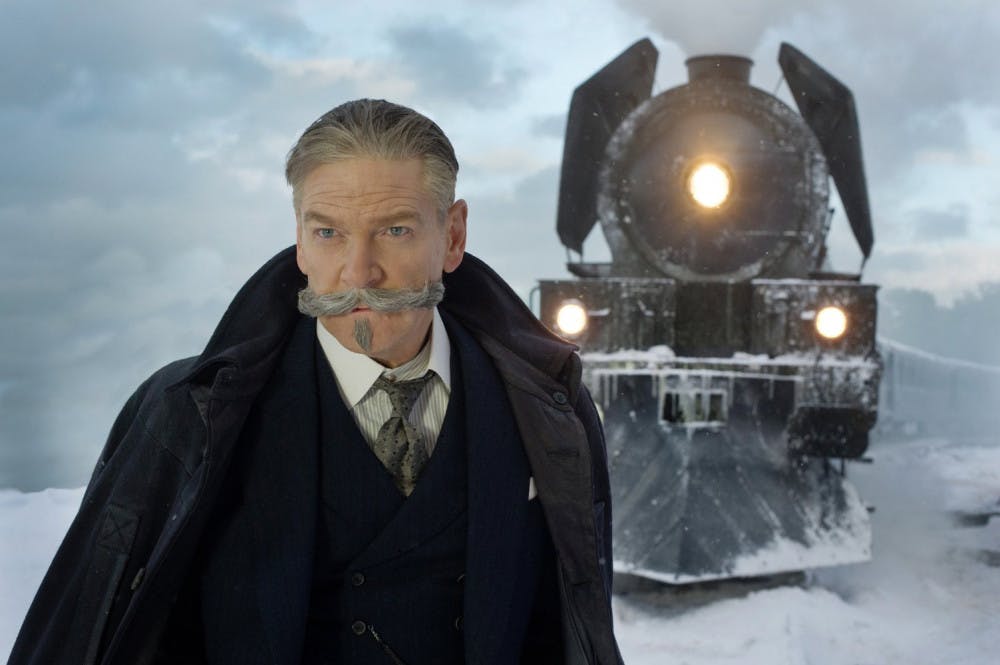All of your favorite stars are cold and suspicious for two hours and we wrote a review about it. Enjoy.
By Stephen Brinkerhoff
TRAILER: https://www.youtube.com/watch?v=Mq4m3yAoW8E
Kenneth Branagh directs and stars in “Murder on the Orient Express,” yet another adaptation of the Agatha Christie’s 1934 novel.

With Branagh, the film also stars Daisy Ridley (Stars Wars: The Force Awakens), Johnny Depp (Edward Scissorhands), Michelle Pfeiffer (Batman Returns), Penélope Cruz (Vicky Cristina Barcelona), Judi Dench (Skyfall), Willem Dafoe (Spider-Man), Leslie Odom Jr. (Hamilton), Josh Gad (Frozen), Derek Jacobi (Cinderella), Tom Bateman (Da Vinci’s Demons) and Olivia Colman (The Night Manager), *gasps for air.*
Stuck in an avalanche and face to face with the murder of a passenger, renowned detective Hercule Poirot (Branagh) is tasked to deduce who the killer is from a train car full of suspects (everyone else).
It should be said that this film is beautiful to look at. It was shot on 65 mm film, and in a time where nearly every film today is shot on digital, this format has become somewhat of a novelty, recent being used on Christopher Nolan’s Dunkirk.
Cinematographer Haris Zambarloukos’ work with the film format allows the colors to pop unlike they would in digital, as well as strengthen the look of the film’s already gorgeous costume and set design, which manages to be both stylistic and period accurate.
Likewise, Branagh displays some creative camera work throughout. The film is actually a bit more comedic than some may initially expect, sometimes to the point of bordering on slapstick. Branagh, surprisingly, seems to have a good knack for comedy.
He edits the film and moves the camera with great comedic timing. As for more “artsy fartsy” camerawork, there’s plenty of that as well. Branagh makes use of a lot of long takes, often encompassing a lot of impressive camera movement and, even more impressively, managing to get nearly its entire star studded cast in the same shot.
This is a minor thing, but despite the film’s beautiful cinematography and camerawork, there are a couple where the CGI is noticeable. CGI is mostly used for scenery and sweeping shots of mountain and city scapes in the film. It’s not that bad, considering that the budget for the film is only $55 million, which, believe it or not, is small compared to other films, but there are a couple moments where the screen borders too much on cartoony and it may take the audience out of the film.

The film’s real issue is at the script level. The problem with Michael Green’s script is that it’s just not enough. The story isn’t long enough. There’s not enough mystery. None of the characters are really all that fleshed out, because none of them are given enough time to do so.
The film is only an hour and 54 minutes long, and it could have used another half hour to 45 minutes. What the film needs is a long running time. A feeling of length would have helped the audience sink into the atmosphere, get to know the characters and predict who they think it is.
Poirot is maybe the best character in the film, but it’s less because of the Branagh’s performance and more because he’s just about the only fleshed out character. As he is in the director’s chair, Branagh sports a good sense of comedic timing.
He knows how to comedically work with the camera and he has a couple loud out loud moments. Even then, though, the audience never connects with him because although he is the most fleshed out, he’s still not that fleshed out. The audience never really gets to know him, and thus never sympathizes with him.
As for almost every other actor in the film, there really isn’t much to be said. Everyone is good in the film, but again, their characters have nothing to them. Both the actors and the audience need more time with them. The actors, because they need a fleshed out character to work with, and the audience, because they need to care.
The audience doesn’t get to know these character well enough so that the ending will shock them. With as talented as the cast is, it’s a shame to see their talents squandered on something could have all easily made so much out of.
There is one actor that stands out among the rest, but the issue is that that actor plays the culprit. For the sake of not spoiling the movie, that actor will not be revealed, but compared with every other actor, they’re actually given a good range to develop a character, especially once it’s revealed who they are.
However, another issue is that it’s sort of obvious from the get go that it was them. The reveal isn’t that shocking. This is based on a book, so there’s not much wiggle room, but it would be cool if the filmmakers took some liberties instead of going with the obvious.
“Murder on the Orient Express” is a forgettable adaption of Agatha Christie’s classic. Even with its beautiful cinematography, inventive camerawork and occasional big laughs, the root of the film’s issues is that it never allows its audience to invest themselves in the plot or characters.
The actors do their best with what they’re given, a couple more so than others, but ultimately, it’s not enough to even warrant the film’s existence in the first place.
Film Review: 'Murder on the Orient Express'

Heads up! This article was imported from a previous version of The Campus Citizen. If you notice any issues, please let us know.
The official poster for the film. (Image Courtesy of IMDB)
Director and star Kenneth Branagh. (Image courtesy of IMDB)




